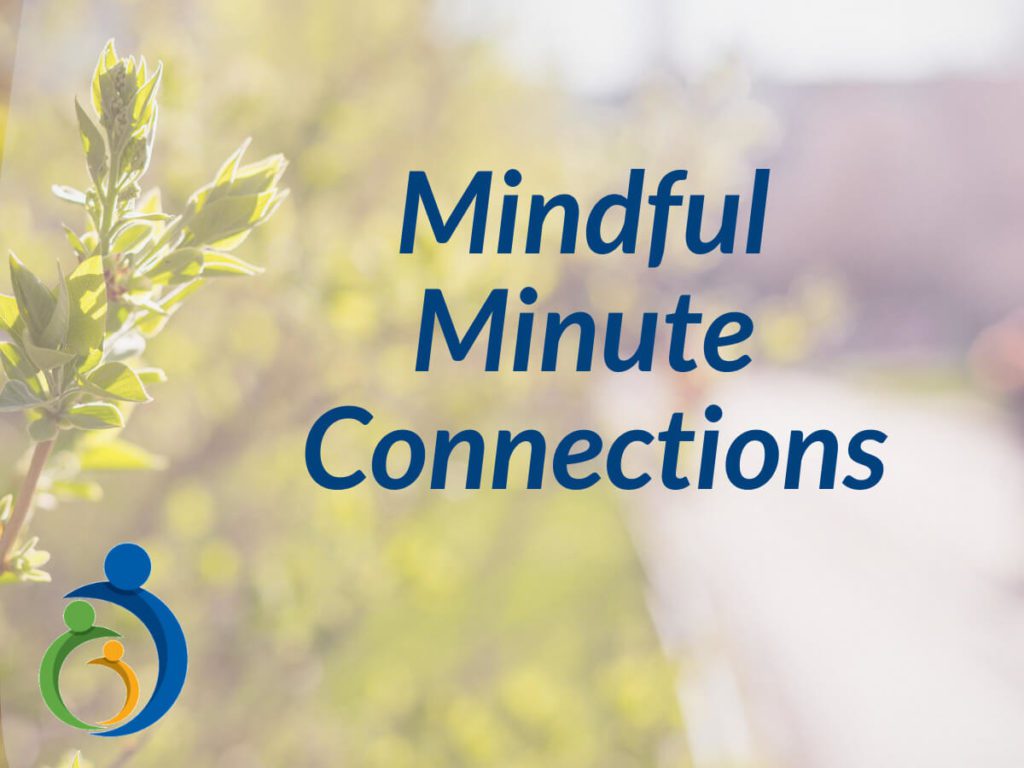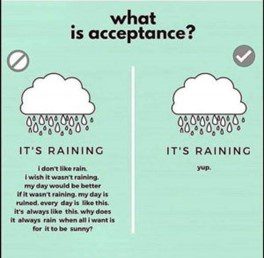
This blog post was written by Shanleigh Bechard, MS, LPC, NCC, a mental health therapist at the Beloit Area Community Health Center. She is currently accepting new clients.
What does it mean to accept something?
Acceptance is a term we often use to mean moving on or letting go. But how often do say we have accepted something when we really have not? We convince ourselves we have moved on, but it still consumes our thoughts. We tell others we have let go, but we still hold resentment. What are you holding on to? What are you resisting?
Why do we resist?
Acceptance is easy when things are going well. When pleasant events come our way, we say yes, turn towards, and open up. But this is not always the case with discomfort. We resist what we don’t like, crossing our arms and digging our heels in when we don’t get our way. It makes sense we do this. We are trying to protect ourselves from pain. Why would we want to face the reality of something we don’t like or didn’t plan?
Resistance can show up as denial, anger, resentment, fear, anxiety, stubbornness, or avoidance. We often look to external things to help us cope with not only the discomfort of reality, but the discomfort of the resistance we have created in response to reality.
Alcohol, food, TV, video games, shopping, work, and social media are examples of external distractions we use to avoid. These things feel good in the moment, helping us numb and distract from what we don’t want to feel. We trick ourselves into believing that if we avoid the discomfort of reality, it doesn’t exist.
But we cannot selectively feel. We cannot choose to feel only the pleasure while numbing all the pain. By choosing to numb the pain of reality, we numb everything, including the joy. Only when we fully open ourselves to the entirety of reality, both the pleasure and the pain, can we fully experience happiness.
What is radical acceptance?
Radical acceptance is for when we cannot keep painful events and emotions from coming our way.
To radically accept something means to fully and completely recognize and acknowledge the truth of reality. It’s when we stop fighting reality, stop resisting because it is not the way we want, and let go of bitterness. It is being present in the moment. It is acting skillfully and effectively, doing what is needed for the situation we are in, not the situation we wish we were in; not the one that is fair; not the one that is more comfortable.
Radical acceptance is seeing reality as it is. It is what it is.
What radical acceptance is not.
Radical acceptance is not approval. It is not agreement. It is not condoning, excusing, or turning the other cheek to other’s behaviors. It doesn’t have to mean liking reality or having compassion. Radical acceptance is not passivity, and it is not giving up. It is not throwing the towel in, and it is not against change.
We can believe fully that something is not right or fair, and at the same time accept it to be true. We can feel deep disagreement with something and still acknowledge it as reality. Both can be true.
Why radically accept?
If you’ve read this far, you are probably thinking something like, “Wow, this seems really hard and painful. Why would I ever want to accept painful things when I can continue to avoid?” To answer this, we need to get real with ourselves. How well is resisting and denying reality really working?
Think about a toddler after a tantrum. They are a hot mess: exhausted, depleted, and disorganized. They have been ineffective with their energy, and usually have not gotten what they wanted in the first place.If we are honest with ourselves, we throw tantrums of our own. The resistance we carry is physically, mentally, and emotionally draining. It is a waste of energy and it’s keeping us stuck. With radical acceptance, we say no to tantrums and resistance, shifting our energy from cultivating resistance to cultivating peace.
Consider the following:
- Rejecting reality does not change reality.
- Changing what we can about reality first requires accepting reality.
- Pain cannot be avoided, and it’s our body’s way of sending us information.
- Rejecting reality turns pain into suffering. Pain is part of life and cannot be avoided. Suffering is entirely in our control and is a sign we are making things worse for ourselves.
- Refusing to accept reality keeps us stuck in unhappiness, bitterness, anger, sadness, shame, disconnection, and other painful emotions.
- Acceptance may lead to sadness or grief, but deep calmness usually follows. If acceptance was easy, we would have done it already. We can expect that when we finally accept reality as it is, it will be painful. But the suffering then dissolves, leaving room for peace.
- Enduring the pain of accepting reality is the path out of suffering.
“Radical acceptance rests on letting go of the illusion of control, and a willingness to notice and accept things as they are right now, without judging.”
Marsha Linehan
How do we radically accept?
- Pause. When you encounter discomfort, pause. Take a step back and take a few deep breaths to interrupt the pattern of resistance. You may notice tension in your body or a negative narrative playing in your mind. Notice the urge to fight, to run, or to avoid the discomfort. Notice that you may be fighting a battle with reality. During this pause, allow yourself to be fully present with how you feel in your body and mind.
- Name. Label the painful event or emotion without judgment. Identify what you are feeling and give it a name. Naming the experience brings it into existence, to the here and now.
- Say yes. Soften your body and mind and say yes. Turn towards the pain and open yourself to it, even if you don’t feel ready. Remember, you’ve been feeling what’s there all along, just not all the way. Simply acknowledging any resistance, fear, denial, or pain, or what you are avoiding starts the process of acceptance.
- Self-Soothe. Sitting with the discomfort is…uncomfortable. Notice any judgments and instead offer yourself loving kindness. Soothe with deep breathing, calming smells or sounds, or comforting tastes. Offer yourself words of encouragement and surround yourself with supportive people to make the unbearable bearable.
- Repeat. Radical acceptance requires a commitment to turn towards the discomfort again and again; to open and say yes, each time we encounter the avoidance. Every time we choose to turn away from resistance, we move closer to true acceptance.
Fully turning towards the reality of our lives, with all the pains and joys, requires the courage to feel. It requires us to take accountability and responsibility for our choices and our lives. It challenges us to be vulnerable and honest with ourselves and others; to grieve; to apologize; to let go; to move on; to close doors and open others; to change.
Radical acceptance requires trust in ourselves. Only when we can be fully present with our own pain can we move through it and come out the other side.
“The curious paradox is that when I accept myself just as I am, then I can change.”
Carl Rogers
References
Information on radical acceptance adapted from DBT Skills Training Handouts and Worksheets, Second Edition, by Marsha M. Linehan














